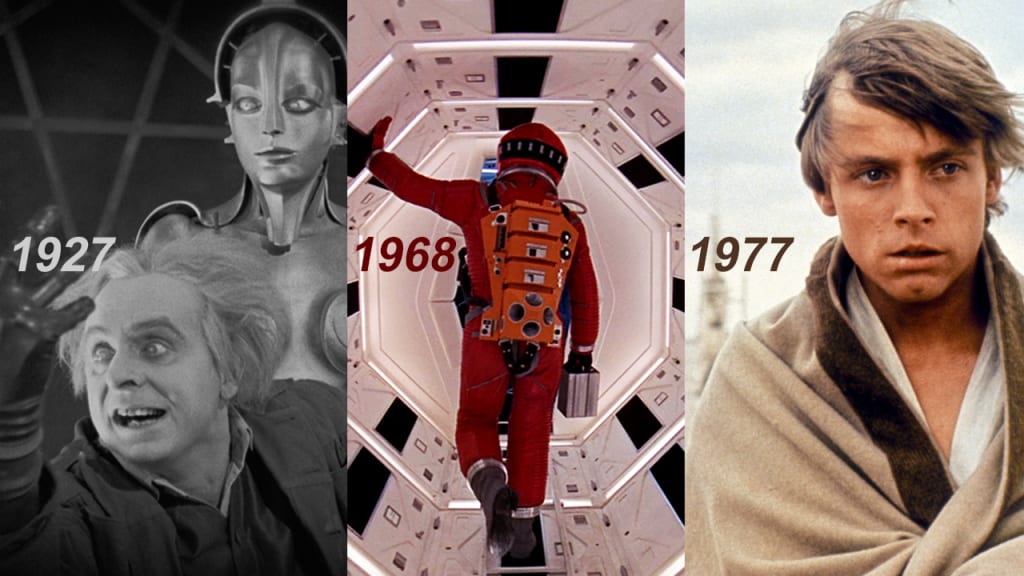
Hot on the heels of Star Wars' 40th anniversary, it's an opportune time to look back on the ripple effect . . . nay, scratch that . . . the tsunami effect it had on cinema history, and how it propelled science fiction into a juggernaut genre at the box office.
Science fiction, and to the same degree fantasy, are genres that are rarely taken seriously or deemed legitimate by anyone outside their respective fandoms. Critics almost universally look down their noses on the genre with head shaking disdain, only tolerating them as mindless popcorn movies to be enjoyed during the dog days of summer when Sirius begins its ride through the skies of the northern hemisphere. Yet American's can't seem to get enough of the genre. They devour these titillating and fantastical tales of drama in the form of books, games, and film to the tune of tens of billions of dollars every year.
For the purposes of this discussion I will be primarily focused on science fiction film, the inflections that defined eras within the genre, and the overall rise of this genre as a whole to become an undisputed box office powerhouse that just might have saved the modern movie industry. An analogous thesis can be made for the fantasy genre, and I will provide supporting data in both cases.
First, a reasonable line in the sand must be drawn to define these broad genres . . . per my own interpretation. I will not go down the rabbit hole of subgenres. Let's keep this broadly simplistic.
- Science fiction (sci-fi) deals with fantastical stories that involve science, the extrapolation of science, and/or technology. Examples being: Star Wars, Iron Man, Jurassic Park, Terminator 2, etc.
- Fantasy deals with fantastical stories that DO NOT involve science, the extrapolation of science, and/or technology. Examples being: The Fellowship of the Ring, Toy Story, Harry Potter, Shrek, etc.
- Non-science fiction/fantasy deals with non-fantastical, historical or contemporary stories, primarily grounded in drama, comedy, or action. Examples being: The Godfather, Cast Away, Saving Private Ryan, Blazing Saddles, etc.
As a clarifying caveat, most sci-fi/fantasy own elements from other genres such as drama, comedy, action, but this does not detract from the fact that they are first and foremost sci-fi/fantasy films.
Now that we have some clearly established constraints let's define The Three Eras of Science Fiction Cinema.
The Pre-Modern Era of Science Fiction (1927-1968)
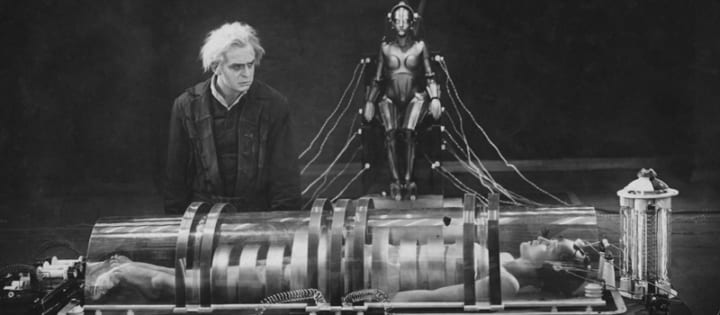
Metropolis (1927)
Prior to 1927, in the infancy of Hollywood, there really was no appreciable sci-fi genre. Then Fritz Lang's masterpiece Metropolis (full version at this link) burst onto the scene and it was the first time that the genre had taken on an element of respectable Realism. Prior to Metropolis the level of realism present in fantastical tales where offerings such as 1902's A Trip to the Moon, by Georges Méliès. Groundbreaking for its time to be sure, but essentially still a crude story severely crippled by the limited production technology of the day. The creation and release of Metropolis was the first instance of realism being attached to the genre, fundamentally due to its prescient and groundbreaking special effects and its still timeless storytelling. But it came at a price . . . the production was the most expensive movie of its time.
Box office data is very sketchy for that period, but my research indicates that Metropolis had a modest showing, but was not a hit by any means. Regardless, it's lauded as science fiction classic nearing its 100th birthday.
In 1985 Roger Ebert proclaimed:
"Metropolis is one of the great achievements of the silent era, a work so audacious in its vision and so angry in its message that it is, if anything, more powerful today than when it was made. ... Metropolis does what many great films do, creating a time, place and characters so striking that they become part of our arsenal of images for imagining the world."
It heralded a new era of science fiction cinema.
The Post-Modern Era of Science Fiction (1968-1977)
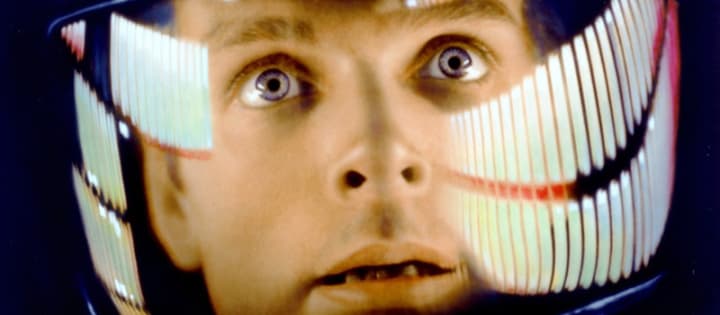
2001: A Space Odyssey (1968)
The general "Golden Age" of science fiction storytelling (1938-1946) fell squarely within the Pre-Modern era of science fiction in cinema, lending it additional levels of scientific realism as the decades marched on. But there was still an element missing in the genre. At the time science fiction was considered pulp; nothing more than literary and artistic frivolity and distraction in a timeframe that heavily favored dramas and musicals on the silver screen. Following the end of World War II, the paranoia of the Cold War fueled much of the storytelling in Hollywood.
That would all change in 1968 when the young and future legend Stanley Kubrick worked with the already established legend Arthur C. Clarke to bring 2001: A Space Odyssey to the screen. This film would be the beginning of the short lived Post-Modern era of science fiction cinema. Through their meticulous attention to scientific detail they managed to introduce the element the genre needed most: legitimacy. Despite what many would believe to be a confusing script, and even more who would misunderstand the message or plot elements (purposefully left vague by Kubrick), there was nearly universal praise for the realism depicted.
In 1968 The Observer (UK) wrote the following about 2001: A Space Odyssey:
"A mere dozen years ago, fairly typical of the science-fiction film as a whole, a pathetically tatty epic called King Dinosaur wobbled unsteadily across our screens, its cardboard spaceship wilting visibly whenever touched, its astronauts emerging one by one because the budget obviously couldn't rise to space suits for them all. Since then the genre has acquired not only its lettres de noblesse, but a lot of money to play with: and the first thing to be said about Stanley Kubrick's 2001: A Space Odyssey – several years in the making and costing heaven knows how much – is that it looks quite simply stunning."
With one historical cinematic inflection point, all those "tatty epics" were no longer going to be acceptable cinema fair thanks to the work of Kubrick and Clarke. While 2001 was indeed a box office success, it lacked the one thing (or two) that held it back from bigger success: characterization and story development. But it forever legitimized the "science" in science fiction for an audience of future filmmakers.
One young film student in particular took notice.
The Blockbuster Era of Science Fiction (1977-present)
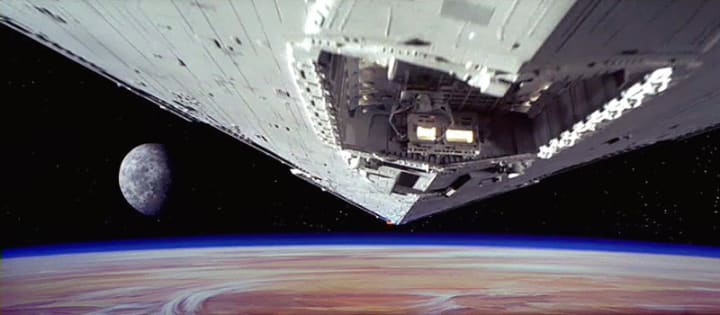
Star Wars Episode IV: A New Hope (1977)
The Post-Modern era of science fiction in cinema was short lived, lasting only nine years (1968-1977). During this era many classics of science fiction were made for the screen: Silent Running, Logan's Run, A Clockwork Orange, Solaris, Planet of the Apes, etc, yet none became breakout hits. None of them stormed the box office and became escapist "must see" spectacle type of events.
That all changed on May 25, 1977 when a scrappy, 33 year old George Lucas, who had battled with studios for years to get it made, would change cinema history forever by releasing Star Wars on a completely unaware, unprepared, and unsuspecting audience. Obviously this was the pre-internet years, opinion spread by word of mouth, and it didn't take long for Star Wars to become one of the biggest blockbusters of all time.
It might be difficult for people who weren't around at the time to understand the magnitude of its popularity. In 1977 there were far fewer theaters than there are today. Here's a comparison of estimated domestic ticket sales with other popular movies:
- Gone with the Wind (1939) - 202,044,600 tickets
- Star Wars (1977) - 178,119,600 tickets
- Titanic (1997) - 135,474,500 tickets
- Star Wars: The Force Awakens (2015) - 108,115,100 tickets
- Avatar (2009) - 97,255,300 tickets
Modern blockbusters, being shown on multiplexes on thousands of screens each weekend, can't hold a candle to Star Wars. There were lines around blocks, all day, for weeks on end. In adjusted dollars it is still the second biggest domestic blockbuster in history, slightly behind Gone with the Wind which was a dramatic phenomenon in 1939, beating even the mighty Star Wars in ticket sales. But this was before science fiction and fantasy became king of the box office.
With his release of Star Wars, George Lucas introduced the last elements to the genre that would turn science fiction into massive box office draws: characterization and story.
In 1977 Roger Ebert wrote the following:
"Every once in awhile I have what I think of as an out-of-the-body experience at a movie. ... Star Wars works like that. ... The movie relies on the strength of pure narrative, in the most basic storytelling form known to man, the Journey. ... We get involved quickly, because the characters in Star Wars are so strongly and simply drawn and have so many small foibles and large, futile hopes for us to identify with. ... But the magic of Star Wars is only dramatized by the special effects; the movie's heart is in its endearingly human (and non-human) people."
The Blockbuster era was born, and cinema would never be the same.
Analyzing the Data

Now that we've defined the Three Eras of Science Fiction Cinema, and how science fiction transitioned into a legitimate cinematic art form, how do we show that Star Wars changed the cinematic world? Nearly everyone knowledgeable on the subject takes it on face value as fact, with barely an argument to be found.
Data mining and visualizing can be the coup de grâce in any debate, backing of a theory, or idea. My intent is to clearly show what everyone so easily accepts as fact. To do so I need data . . . lots of data. So I turned to the popular box office site, aptly named, boxofficemojo.com. Instead of trying to extract all historic data, I used the more manageable Top 200 Adjusted Domestic Grosses (ADG) films, from 1921's The Four Horsemen of the Apocalypse, extending to the most recent hit on record Beauty and the Beast (2017).
I'm only focusing on domestic (United States) box office data and this study does not include international data. Domestic data is more accurate in accounting, and thus more accurate when applying ticket price inflation modeling assumptions used by boxofficemojo.com.
Per boxofficemojo.com, the Adjusted Domestic Gross (ADG) is:
"Adjusted to the estimated 2017 average ticket price of $8.84. Inflation-adjustment is mostly done by multiplying estimated admissions by the latest average ticket price. Where admissions are unavailable, adjustment is based on the average ticket price for when each movie was released (taking into account re-releases where applicable)."
Thus, in the following visualizations each movie has been normalized to a 2017 box office take, IF that film were to be released today and had the equivalent number of admissions as when it was released. A level playing field for comparison.
In the data it will become shockingly clear how domestic viewer preferences, based on the domestic (United States) top 200 movies of all time, have morphed over the years, what the potential impetus for those changes might be, and how sci-fi (and fantasy) have become an undeniable dominant force in cinema.
Genre Breakdown of the Top 200 ADG Films, 1921-2017
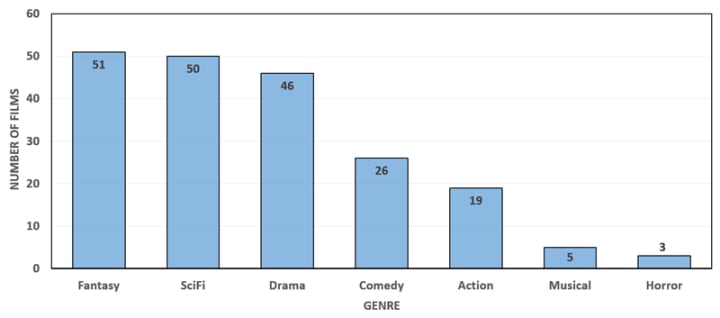
But first, let's take a look at the breakdown of genres in the Top 200 ADG Films. Fully 50% (101 out of 200) are comprised of what I consider to be films with primarily science fiction of fantasy themes. Drama is nearly equal to each of those genres in the Top 200, with other genres falling off after that. What you will see in the following data is that the distributions of films within these genres vary greatly over the 100 years covered. There are clear demarcations where viewing and studio preferences start to shift.
Sci-Fi Films in the ADG Top 200, 1921-2017
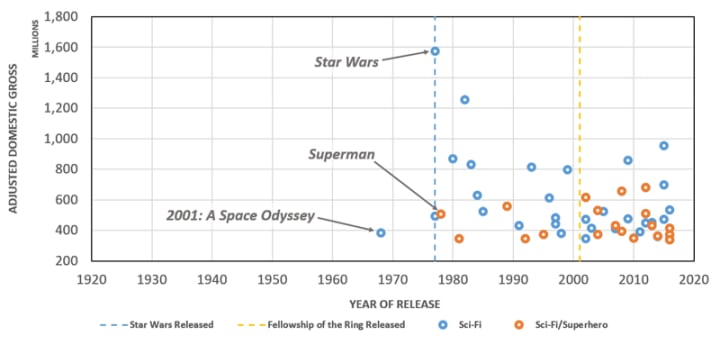
Just look at that eye opening chart. 25% of ADG Top 200 films are science fiction, but only a single one (2001: A Space Odyssey) from that distribution made the list prior to 1977! Following the release of Star Wars there was a deluge of blockbuster sci-fi that simply did not exist prior. Furthermore, 1978's Superman helped kick off the Blockbuster Era of superhero hits, the vast majority being a subset of sci-fi. Prior to that there were zero sci-fi movies with a superhero basis that made the list. Traditional sci-fi movies appear to slightly outperform superhero based sci-fi at the box office to the tune of approximately $100 million (adjusted) on average per film. It's unclear if the release rate of sci-fi films is accelerating, but what is clear is that domestic (and more than likely international) viewers love big spectacle science fiction movies. And you can thank George Lucas for that!
Fantasy Films in the ADG Top 200, 1921-2017
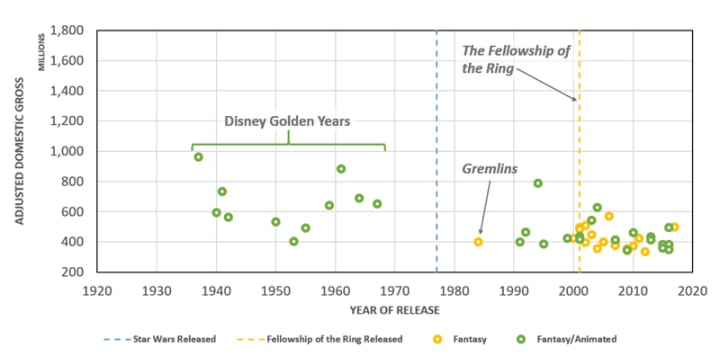
Analogously, let's take a look at fantasy films in the ADG Top 200 film list. From 1970 to 1990 there was a drought of fantasy genre hits, and prior to that all fantasy hits were traditionally cel animated, and most were the property of Walt Disney. CGI (computer-generated imagery) animation was still a long way off. Perplexingly there's a 20 year drought in box office fantasy hits, with 1984's Gremlins being the only exception. Did 2001 and/or Star Wars have something to do with this? Hard to say.
The landscape began to slowly change in 1986 when Pixar was established and began its quest for animation domination, eventually releasing Toy Story in 1995 and changing the animation forever. Most of the animated fantasy hits beyond that date were all produced with CGI (Shrek, Finding Nemo, Monsters Inc., etc).
But the real story with this dataset is 2001's The Fellowship of the Ring which caused a storm of live action fantasy productions (yellow markers). It did for fantasy what 2001 and Star Wars did for science fiction . . . it made the genre legitimate and worthy of popular escapism in the eyes of general audiences.
Drama & Comedy Films in the ADG Top 200, 1921-2017
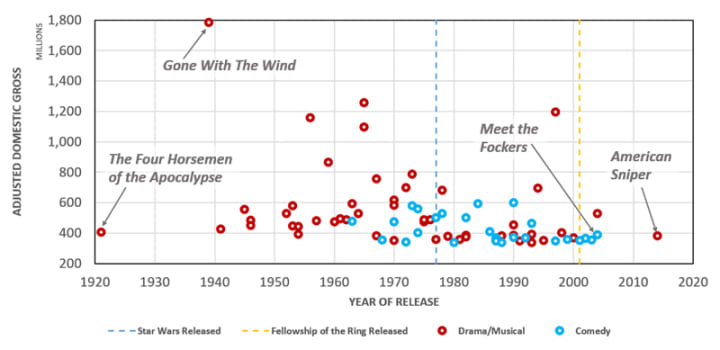
Drama was king prior to Star Wars. The biggest hit of all time, in ADG, is 1939's Gone With the Wind. After 1977 there was a severe falling off of dramatic hits that seem to fall off a cliff in 2001 when The Fellowship of the Ring was release. Causality? Unsure, but it is clear that audiences and studios abandoned pure melodrama in favor of more escapist forms of fantastical drama. In the last 16 years there have only been two hits that land on the ADG Top 200 from the drama genre: The Passion of the Christ (2004) and American Sniper (2014). It could be argued that the latter might fall in the action genre, leaving only a single dramatic hit in the Top 200 in the last 16 years.
On the other hand, comedies have never really been blockbusters. They had a healthy run from the mid-1960s until shortly after 2001. But like drama, the comedy genre has not had a bona fide blockbuster hit since 2004's Meet the Fockers.
There was another inflection point in United States society in 2001 . . . 9/11. This is purely conjecture, but has our domestic society become more serious, more grim, more pessimistic since that tragedy? Has it caused us to seek out more sophisticated and "further from the norm" forms of escapism? Have we abandoned drama and comedy to the point that there are no more hits being generated due to changing attitudes in the U.S.? Again, it may not be causal, but the trend is clear.
Action/Thriller Films in the ADG Top 200, 1921-2017
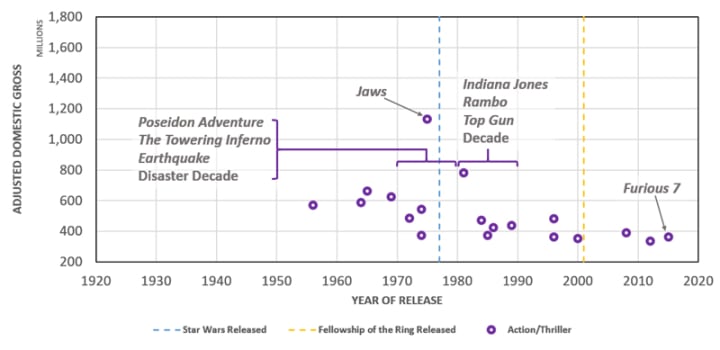
Pure action hits in the ADG Top 200 (outside primarily sci-fi and fantasy genres, which often have action elements) are relatively sparse, but have been consistent since the mid-1950s. There have only been three domestic action hits (that were not sci-fi or fantasy) since the turn of the new century, with what appears to be a slow downtrend in releases and box office. Action films hits have been transferred to the sci-fi and fantasy genre, both of which pack plenty of punch to get viewers' blood pumping. Gone are the days when films like Rambo and Top Gun ruled the box office.
The New Paradigm
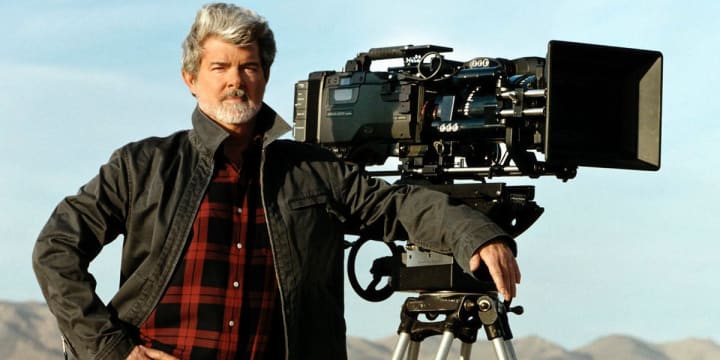
George Lucas, creator of Star Wars.
George Lucas may be retired and no longer at the helm of the franchise he created, but there can be little doubt that science fiction, in all its forms, now dominate modern cinema due to his early genius. The impetus for this paradigm shift was George Lucas' visionary spectacle Star Wars. Few would argue that it didn't have an impact on cinema, but when one sits down and looks at the data it's shocking to see that Hollywood almost immediately made a dramatic focus shift based on its impact.
Let this piece of data sink in. 101 of the ADG Top 200 films fall within the sci-fi/fantasy genres over the past 100 years. But 89 of those 101 didn't make the Top 200 list until after 1977! 89% of sci-fi/fantasy landed on the list in only the last 40% of Hollywood's history . . . only after the release of Star Wars! The same associative extrapolation can be made between tales of fantasy and The Fellowship of the Ring.
Why is this? I posit that most people (not just citizens of the U.S. which is where this data is drawn) are looking for more fantastical forms of escape from what seems to be a more complex and dire world in which we live. Furthermore, science fiction has evolved far beyond its infancy. It now possesses critical elements which give the genre much broader appeal to the masses: realism, legitimacy, characterization, and timely (if not entertaining) plots. Dystopian tales have been particularly popular lately as we become more pessimistic about our future as a planet and as a race.
As a reflection of being a more "acceptable" genre, sci-fi actually IS being taken more seriously by critics. It used to be that sci-fi films were only awarded for technical achievements (special effects, costumes, etc). More and more we're seeing awards (and nominations) for writing, directing, and acting. Gravity recently won seven Oscars, including one for Best Director. Heath Ledger posthumously won an Oscar for his portrayal of The Joker in The Dark Knight. The Martian and Arrival were nominated for a combined 15 Academy Awards.
Fans of science fiction and fantasy should no longer feel any stigma for loving the genres . . . everyone does, whether they admit it outright or not! The data shows it. Nor should fans lament about the decline or perceived unacceptance of science fiction. You're established, ingrained, and entrenched, so stop worrying! Sure, the argument can be made that a box office hit doesn't necessarily equate to quality. Yet for some inexplicable reason we keep flocking in droves to Transformer and Pirates of the Caribbean movies with no end in sight! Hey, Michael Bay loves this new paradigm! If you want to see "better" science fiction coming out of Hollywood, spend your money making films like Arrival, Gravity, The Martian, Inception, Children of Men, and The Edge of Tomorrow mega blockbusters so we'll receive fewer Transformers!
Hollywood will keep making sequels, reboots, and original science fiction because they can't seem to quash our insatiable desire for exotic escapism.
For fans of the genre, the future is bright indeed.
About the Creator
Neal Ulen
Neal is a writer and recovering engineer who likes pizza, the insidious power of sarcasm (and pizza), and debating science fiction (and pizza). You can find him at http://infinispace.net






Comments
There are no comments for this story
Be the first to respond and start the conversation.